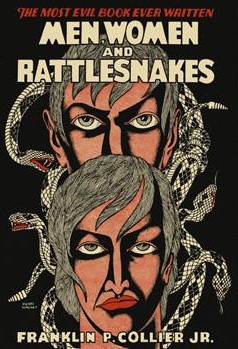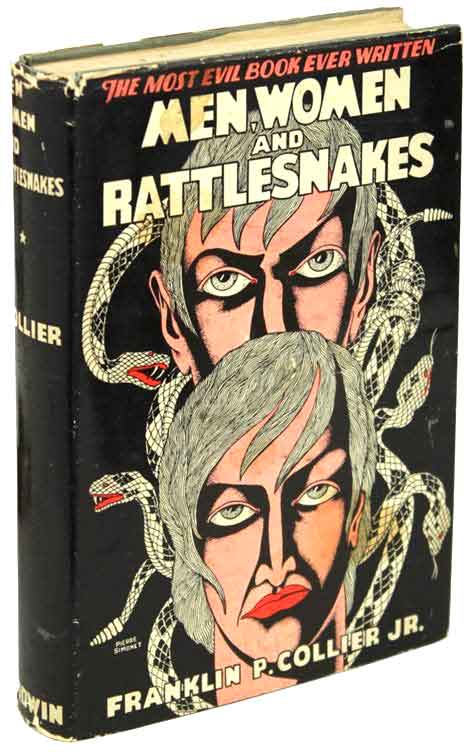 By FRANKLIN P. COLLIER JR. (William Godwin, Inc.; 1933)
By FRANKLIN P. COLLIER JR. (William Godwin, Inc.; 1933)
The “Most Evil Book Ever Written”…? So claims the cover of this long forgotten 1933 novel, whose jacket description name checks William Faulkner’s SANCTUARY and Sherwood Anderson’s WINESBURG, OHIO. The latter book is known for providing a (fictional) peek behind the veneer of a seemingly idyllic small town to uncover a web of ugliness and depravity, a trope that has undergone further elaboration in texts ranging from PEYTON PLACE to THE WATCHER.
The “Most Evil Book Ever Written”…?
Where MEN, WOMEN AND RATTLESNAKES parts ways with those novels is in its overall approach, which offers the reader no point of normalcy to counterpoint the sordid doings of its characters, and also the fact that it hasn’t dated as poorly as you might expect, being in many respects just as impacting now as it was back in ‘33.
The setting is Menham, a rural farming town in some unspecified region (a Southern one, evidently) of America. Its residents, a uniformly racist, misogynistic, petty and sadistic bunch, tend to congregate in a salon owned by one Lee Witherbee, who hosts a men’s-only drinking club on Saturday nights. Not to be outdone, the ladies of Menham get together to form their own alcoholic fraternity in the town hall.
…offers the reader no point of normalcy to counterpoint the sordid doings of its characters…
Standing aside from them all is Miss Hummer, an insanely prim, virginal spinster who adopts a child. She wants a girl but gets a boy. No matter: she names the boy Henrietta and raises him as a female, with everyone in town buying into the ruse (and believing she birthed the child herself). Miss Hummer’s hatred for all things male results in the boy being subjected to a steady retinue of beatings and neglect; unsurprisingly, Henrietta grows into a mentally deficient man whose only friend is a tree, and who knows but one word: “slut.”
As is the case with many of the characters in this novel, Miss Hummer has an opposite sex counterpart: Arthur Moore, a rattlesnake breeder who hates women as much Miss Hummer does men. The reason for his attitude is a short lived marriage that went sour, and concluded with his wife being dispatched by one of his prized snakes. This is the first of several snakebite deaths, dealt by rattlers strategically left by Arthur near the homes of people he doesn’t like.
Henrietta grows into a mentally deficient man whose only friend is a tree, and who knows but one word: “slut.”

Another pivotal character is the town lothario Peter Brush, who strings along six women and fathers a child with each; those children, boys all, grow into a collective known as the Peters (seeing as how each is named after his father) that wreaks all manner of mischief. Peter’s female counterpart is Minnie Muller, a young woman who after failing in her attempts at finding love elects to reject monogamy altogether and entertain multiple boyfriends.
That particular plot strand was obviously far more shocking to readers in 1933 than it is now, as is another in which May, a sleepwalker, is impregnated during one of her nocturnal jaunts. Miss Hummer’s abuse of Henrietta, however, remains deeply upsetting, while another subplot, involving Sadie Sadler, a woman who fills her house with mice in the belief that the critters are reincarnated humans, retains much of the sardonic humor of its conception, particularly in a passage in which a mouse escapes from a fold in Sadie’s dress to disrupt a session of the ladies’ drinking union.
Author Franklin P. Collier Jr., whose first novel this was, relates this lunacy in a style that in later years would be termed hard-boiled. The prose is frank and unaffected, with nary a wasted word or overwrought description, which has the effect of intensifying the ugliness and bizarrie.
The prose is frank and unaffected, with nary a wasted word or overwrought description, which has the effect of intensifying the ugliness and bizarrie.
Speaking of hard-boiled, MEN, WOMEN AND RATTLESNAKES would probably have been better received in the form of a paperback from that era, alongside the more excessive novels of Jim Thompson (such as WILD TOWN and KING BLOOD), than as the prestige hardcover its publishers issued. There’s nothing especially prestigious about Collier’s pulpy sensationalism, which results in a page turner whose violent conclusion (in yet another instance of foreshadowing) directly anticipates the EC Comics denouements of two decades hence. In short, this is a book that was ahead of its time, for which it paid the price.
